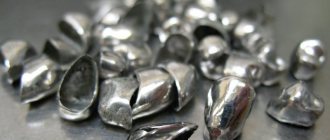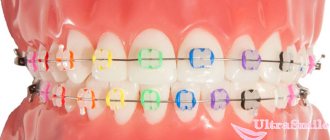Few people decide to undergo orthodontic treatment, believing that it is associated with high costs and discomfort. But often people’s fears are unfounded: installing braces is a multi-step, but safe process that goes without complications. We will tell you how orthodontic braces are placed and what stages this procedure includes.
In this article
- At what age are braces placed?
- Indications and contraindications for installing braces
- How braces are inserted: stages of orthodontic treatment
- How to install braces: diagnosis and treatment plan
- How to install braces: sanitation of the oral cavity
- Is it possible to put braces on crowns and fillings?
- How to install braces
- How to install braces: stages of the procedure
- Does it hurt to get braces?
- Braces activation
- How braces are placed on children and adults - is there a difference?
- How to care for braces
- How are braces removed?
Braces are installed primarily to correct the bite or straighten unevenly growing teeth. According to statistics, about 75% of children have problems with bite. If they are not eliminated in childhood, they will affect the health of teeth and gums in the future. In addition, people with malocclusion and irregularities in the dentition often develop complexes, lower self-esteem and, as a result, have difficulties in building interpersonal relationships.
Today, this problem can be solved in just a few years; you just need to install braces - dental brackets that are fixed to the dentition from the inside and/or outside and gradually straighten the teeth to a normal state. There are many rumors and myths surrounding the topic of orthodontic appliances.
Many people believe that getting braces is dangerous and painful, they cause discomfort, interfere with eating normally, etc. Such ideas are generated by ignorance. We'll tell you how braces are installed and how the preparation for their installation goes.
At what age are braces placed?
Braces are placed on both children and adults. Dentists say that the optimal age for orthodontic treatment with braces is 12-13 years. During this period, the final formation of the bite and the replacement of milk teeth with molars occurs. Pathologies in the structure of the dental system discovered in a teenager are eliminated faster than in adulthood.
In some cases, braces are placed earlier - at 8-11 years. However, if a person has missed this point, he can correct the problem as an adult. Of course, the treatment process will be longer, but no less effective. There is no upper age limit as such: an adult can be prescribed to wear braces as long as he has teeth, and bite correction is justified in terms of indications and contraindications.
What is the difference between ceramic braces and metal braces?
Many patients are interested in what is better - ceramic or metal braces. You need to understand that both types of systems cope well with their task, the only question is in the details.
When choosing ceramic or metal braces, you should decide on your priorities: aesthetics or treatment time? Ceramic systems are practically invisible on the teeth, and this makes the correction psychologically more comfortable. On the other hand, if it takes a year and a half to correct a moderate defect with metal braces, then with ceramic braces it will take about two years.
Lifestyle will help you understand which braces are better - ceramic or metal. Metal is much less capricious: it does not stain under the influence of red wine, tea and coffee, and is also not prone to chips and cracks.
Another popular question is whether it is possible to smoke with metal braces. If we do not take into account the harm from smoking as such, then it is really better for smokers to install a metal system, since ceramics can change color under the influence of resins.
Indications and contraindications for installing braces
Braces are placed to eliminate the following dental problems:
- malocclusion;
- uneven development of the jaws;
- anomalies of individual teeth;
- deformation of the dentition;
- chewing dysfunction;
- impacted teeth;
- large interdental spaces.
Contraindications to wearing braces can be absolute or relative. Among the first, which completely exclude the possibility of installing an orthodontic structure, are:
- absence of most of the teeth;
- some oncological pathologies;
- blood diseases;
- diseases of the endocrine system;
- very weak immunity;
- pathologies of the skeletal system;
- tuberculosis and HIV;
- psychiatric disorders.
Relative contraindications are temporary. These include:
- periodontal disease;
- caries;
- wounds in the oral cavity;
- metal implants;
- poor hygiene.
Braces can be placed only if the listed factors are eliminated. Indications and contraindications are identified during diagnosis - the first stage of installing orthodontic brackets.
Resilines fastening system
Fixing Resilines braces is another modern method practiced in dentistry. This is the most popular adhesive for attaching braces. Its adhesive properties are very soft and sticky, ideal for bonding any type of overbite correction. Using the composition it is possible to fix metal, sapphire and ceramic products. The adhesive quickly hardens under the influence of ultraviolet lamps. But until the braces are glued and the locks are installed, it remains soft. The metal arch can be installed immediately after attaching the locks.
Regardless of the chosen method, the orthodontist, first of all, needs to focus not on the method of fixation and type of brace system, but on the doctor’s expertise. With the right approach, any of the methods will be effective.
How braces are inserted: stages of orthodontic treatment
The process of installing braces, that is, fixing them on the teeth, lasts about 1.5-2 hours. Preparation takes much more time. In general, treatment includes the following steps:
- Diagnostics: obtaining x-rays, on the basis of which braces will be made.
- Drawing up an individual treatment plan, advising the patient on preparation for the procedure.
- Sanitation of the oral cavity, treatment of diseases of the teeth and gums: caries, inflammatory processes, etc.
- Installation of an orthodontic structure, fixing it on the dentition.
- Assistance in adaptation: doctor’s recommendations regarding nutrition and care of teeth and braces during the treatment period.
Let's look at these stages in more detail.
Varieties
All braces are divided into two large groups: lingual and vestibular. The first ones are as inconspicuous as possible, as they are attached to the inside of the dentition. Their existence will be known only to the patient himself and his treating doctor. The second option is attached to the front of the jaw, so when speaking, such brackets are more noticeable.
Orthodontic structures also differ in their operating principle. Non-ligature models are more modern; they reduce the number of visits to the dental clinic and speed up the process of correcting pathologies. Due to the absence of ligatures (rubber bands or rings for fixing the arc), friction between individual structural elements is reduced, so treatment is quick and more comfortable. Caring for these braces is much easier.
Classic, ligature brace systems require constant monitoring by a specialist. The orthodontist must adjust the tension of the metal arch, due to which the teeth gradually move into the desired position. In general, treatment is longer.
How to install braces: diagnosis and treatment plan
Diagnostics allows you to identify contraindications, assess the condition of teeth and gums, take pictures and develop a further treatment plan. After the diagnostic examination, approximately a week passes, during which the doctor analyzes the material and draws up a plan for installing orthodontic structures. There may be several such plans and they differ in the method of fixing the braces or their type. The patient has the right to choose one of the proposed treatment options. Then the next stage begins - preparing the oral cavity for installation of the structure. Its duration is determined by the condition of the teeth and gums.
Metal braces from different manufacturers
- Damon Q metal braces
are perhaps the most popular on the market due to their patented design and locking system. The advantages of the Damon brand are reliability and reduced treatment time.
- Victory metal braces
from 3M Unitek are considered one of the most attractive metal solutions. They are distinguished by the anatomical shape of the locks and a special surface that facilitates installation. In addition, 3M metal braces belong to the budget category. - Metal braces “Pilot”
are a domestic development that combines an affordable price and quite a good level of efficiency. There are no innovative technologies here, but the solution copes with its main task. - Metal Marquis braces
from Ortho Technology are also in demand among doctors and patients. They are easy to use and especially hygienic: the clasps are precisely adjusted to the teeth and have a low profile, so they are comfortable to wear, and food residues will practically not get stuck between the elements of the system. At the same time, Marquis metal braces allow you to replace arches in the shortest possible time. - American Orthodontics Empower metal braces
are the flagship products in the orthodontic construction market. They are effective and reliable, as well as aesthetically pleasing due to the small size of the locks. However, the cost of their installation will be higher than many analogues. - Mini Master metal braces
from American Orthodontics are miniature in size (25% smaller than other systems). They are “shrunk” not only in width, but also in thickness, which eliminates injury to soft tissues. Mini Master also gives you the opportunity to wear colored metal braces of your favorite shade.
How to install braces: sanitation of the oral cavity
After installing braces, the procedure for brushing your teeth becomes noticeably more complicated and the risk of developing caries increases. To reduce it to a minimum, you need to eliminate all carious cavities. The main task of the dentist is to identify hidden foci of pathology that are located in the interdental spaces.
It is also necessary to eliminate inflammatory processes if they were detected during diagnosis. In other words, it is necessary to cure those pathologies that may become more complicated after installing braces. In addition, at the preparatory stage, ultrasonic cleaning is carried out, during which plaque and tartar are removed.
Some patients are worried that they will have to remove some teeth: “eights”, impacted ones, etc. Extraction is indicated in the following cases:
- crowded teeth;
- teeth that are too large (free-standing);
- presence of extra teeth;
- severe asymmetry of the jaws;
- decaying teeth that are useless to treat.
As a rule, if removal is necessary, it is wisdom teeth, which often erupt with complications: they grow to the sides, remain partially or completely in the gums and subsequently cause malocclusion.
Preparatory activities
Before fixing braces, it is necessary to prepare the oral cavity. For this purpose, rehabilitation is carried out. It is aimed at eliminating accumulations of plaque and stone. At the same time, existing dental diseases are treated. If any chronic pathologies are identified, they are transferred to the remission stage.
Before installing the device, be sure to treat:
- caries;
- pulpitis;
- gingivitis;
- periodontitis;
- periodontal disease;
- root cyst;
- periostitis;
- stomatitis.
If there are partially destroyed tooth crowns, they are restored in advance with composite material. If necessary, intracanal pinning and installation of artificial crowns are performed. Those units that cannot be treated are removed.
Particular attention is paid to professional oral hygiene. During this process, an ultrasonic scaler is used. This device works by performing oscillatory vibrations.
It seems to knock off hard deposits from the surface of the enamel , due to which the latter is completely cleaned and becomes absolutely smooth. This means that the upcoming fixation of braces will take place without complications. Also, after a hygiene procedure, the number of pathogens in the mouth decreases and reduces the risk of gum inflammation.
Is it possible to put braces on crowns and fillings?
Adults, even if they take excellent care of their teeth, have had caries at least once in their lives, so there are almost no patients without fillings or crowns. Their presence is not a direct contraindication to the installation of braces. Modern compounds from which fillings are made form a monolithic structure with dental tissues, so they do not fall out or collapse. They are replaced only if they were installed long ago or incorrectly.
As for crowns, they may require the installation of metal braces, which provide a more reliable and durable fixation. Thanks to this, the crown will be protected from external influences.
Rubber bands
These devices are used when wearing ligature systems and serve as small rods to set uneven dental units in the correct direction.
They are made in the form of small rings from an elastic material and have a smooth surface. This device is suitable for absolutely all patients and does not cause allergic reactions.
Elastic bands serve not only as an auxiliary element when wearing an orthodontic apparatus, but are also used as a decorative means. On sale you can find elastic bands of various shades, which allows you to make a choice based on the individual preferences of the patient.
You should not ignore the recommendation of a specialist on wearing rubber bands. This device is the key to effective and quick correction of the bone organs of the oral cavity.
How to install braces
Braces are installed in two ways: direct and indirect. The essence of the first method is as follows: the clasps of the structure are glued onto each tooth crown using special dental cement and glue. Next, an arc is threaded through them. After fixing the braces, any remaining adhesive is removed.
When using the indirect technique, a plaster model of the patient's jaws is prepared. The dentist places locks on it, and then transfers the finished structure into the patient’s oral cavity. The entire mechanism is glued to the teeth in one go. This method can significantly reduce the procedure time - up to 30-40 minutes. This is about an hour faster than direct installation. Since the patient has to sit with the jaw expander in his mouth all this time, the difference is quite noticeable.
Is it possible to get metal braces inexpensively?
Undoubtedly. Installing regular staples is the cheapest. However, the price of metal braces can vary. Designs with ligatures will cost the least - from 25,000 rubles, a metal non-ligature bracket system starts at 35,000 rubles. Of course, we are talking about vestibular structures, since the price list for lingual systems starts from 100,000 rubles. Ceramic braces with a metal groove will be an order of magnitude more expensive than a conventional system. You also need to keep in mind that metal braces for the upper jaw are more expensive than for the lower jaw. Such designs are the most affordable, and this is also the difference between metal and ceramic braces. The table below will help you navigate the cost of metal structures, as well as a call to a clinic where you can install braces in Moscow.
| Bracket systems | Price |
| Vestibular | from 50,000 rubles |
| Lingual | from 100,000 rubles |
| Mini | from 30,000 rubles |
| Ligature | from 25,000 rubles |
| Unligated | from 35,000 rubles |
How to install braces: stages of the procedure
Braces can be vestibular and lingual. The former are attached to the outside of the teeth, the latter - from the inside. Regardless of what structures are installed, the procedure is carried out according to the following algorithm:
- the patient’s lips are lubricated with cosmetic Vaseline, after which a dilator is inserted into the mouth;
- saliva is removed from the oral cavity using a special tube;
- Glue is applied to the teeth, and medical cement is applied to the clasps that are attached to the enamel;
- Under the influence of an ultraviolet lamp, the cement and glue harden, as a result of which the clasps adhere to the tooth surface.
If the installation is direct, an arc is threaded through the clasps. Indirect fixation involves transferring the finished structure into the patient’s mouth. The arc has a memory effect. Gradually, she returns to the shape that was given to her during the preparation of braces and straightens her teeth.
Rinse aids
To ensure that cleansing procedures remain effective throughout the day, patients wearing braces must use special rinses and solutions.
They contain antibacterial substances of natural origin, which reduce the proliferation of bacteria and prevent the occurrence of inflammatory processes.
Mouthwashes are made on the basis of strengthening and anti-caries substances, which results in the improvement of tooth enamel and the prevention of the development of oral diseases.
Does it hurt to get braces?
Pain during the procedure can only occur if the enamel and teeth are sensitive. If necessary, the doctor will give an anesthetic injection. Once braces are in place, a person may experience discomfort, especially when chewing food. Usually he feels pressure on his jaw, but, as a rule, there is no severe pain that needs to be relieved with medication. Adaptation to braces occurs within 5-15 days, depending on the condition of the teeth.
Proper care
Caring for your teeth after fixing a straightening device is always more difficult. Many times more hard-to-reach places appear in the oral cavity, where plaque quickly accumulates and pathogenic microorganisms multiply. For hygiene to be at a decent level, it is not enough to use only a brush and paste - it is recommended to arm yourself with floss, rinse, and irrigators. After each meal, your mouth should be rinsed. Clean the interdental spaces with floss.
It is better to avoid eating sticky and very hard foods. Toffees, nuts, seeds - all this is prohibited. If the patient eats a balanced diet and takes good care of his teeth, he will reduce the risk of developing caries and other dental diseases that can negatively affect the process of correcting the bite.
Braces activation
Immediately after installation, the braces are activated and begin to correct the bite and irregularities. Gradually, the pressure of the arc will weaken due to the displacement of the teeth. Periodically you need to visit the orthodontist in order to tighten the structure and increase the tension. This will continue for 1-3 years until the dental problem is completely eliminated.
Content:
- Preparatory activities
- Options for installing braces 2.1. Direct method 2.1.1. How it goes 2.1.2. Advantages and disadvantages 2.2. Indirect method 2.2.1. Advantages and disadvantages
What result will be obtained after fixing braces depends on many factors. But the most important thing is that the installation of the leveling structure is done correctly. If you fix the device incorrectly, the teeth will close at the wrong angle. Then there will be no need to talk about any correction of the bite, no matter how long the patient walks with an “iron smile.”
How to care for braces
To reduce the likelihood of developing dental diseases, the patient will have to carefully monitor their diet and oral hygiene. In particular, it is necessary to avoid hard and sticky foods, foods with dyes and smoking. If possible, you should limit your consumption of sweets. For oral care you should purchase:
- a brush with V-shaped bristles (CURAPROX Ortho);
- brush (Curaprox CPS 10, Biorepair Scovolini Interdentali Cilindrici);
- dental floss (Mirafloss implant chx);
- rinse aid with antibacterial properties (Biorepair Mouthwash).
It is advisable to use toothpastes without abrasive substances and periodically (2-3 times a week) clean the oral cavity with an irrigator. To do this, purchase devices that are suitable for caring for orthodontic structures: Little Doctor International Ltd Aquajet LD-A7, Donfeel Donfeel OR-820D Compact, Revyline RL100, Donfeel Donfeel OR-888, Panasonic EW-1411, Revyline RL 200XL, etc.
Hygiene rules and nutritional features
An integral part of orthodontic treatment with braces is constant monitoring of the condition of the oral cavity. After installing the system, if you experience discomfort or pain from rubbing, you should immediately contact your orthodontist. He will correct the design, apply special food-grade wax to the areas of braces that injure the gums, and prescribe medications for the treatment of inflammatory processes in the oral mucosa.
It is very important to develop good eating habits:
- do not eat solid food;
- healthy vegetables and fruits - only grated or cut into pieces, but in no case whole;
- exclude everything crispy and sticky (crackers, toffee, chewing gum, caramel, etc.);
- avoid sweets and soda to protect tooth enamel;
- Avoid very hot and cold drinks—temperature changes can cause braces to come off your teeth;
Anyone who wears braces is recommended to brush their teeth every time after eating, most thoroughly before going to bed. It is necessary to use tools such as:
- orthodontic brushes (with a small compact head and a V-shaped recess in the middle) for high-quality and gentle cleansing;
- dental floss (preferably orthodontic);
- an irrigator that will help remove food debris, plaque, and also prevent bleeding by massaging the gums;
- brush-brush for cleaning locks and removing stuck food in braces;
- restorative mousses with minerals.
It is recommended to visit a hygienist for professional teeth cleaning approximately once 3 months.
How are braces removed?
Dismantling of the structure is carried out in the dentist’s office and is carried out in several stages:
- using a special tool, the locks are unfastened;
- the arc exerting pressure is disconnected from the locks;
- each lock is removed using tweezers;
- Solvent removes remaining glue from the enamel.
To consolidate the results of treatment, the patient wears a plate for 2-3 weeks to straighten the teeth and protect them from stress. Immediately after removing braces, ultrasonic cleaning or whitening can be performed.
Instructions for making braces
How to make braces? Not very difficult. You can make devices from available items.
Here is a list of materials that will be needed during the process:
- Large size paper clips.
- Wire.
- Paper plate or other convenient surface.
- Sandpaper.
- Super glue.
- Pliers.
- Orthodontic wax.
- Beads (preferably different colors).
- Earrings in the shape of a butterfly.
So, let's describe the technology of how to make braces at home.
Braces at home from a paper clip
- Bend the object into a straight line.
- Make the paperclip into the shape of a tooth row, that is, bend it in a U-shape.
- Go to the mirror and stretch your mouth into a smile. Assess how many teeth are visually visible. By counting them, you will find out how many beads you will need in the future.
- Take the beads and attach them to the paperclip. Remember to maintain the correct distance between objects, equal to the distance between the teeth. The beads should be located directly in the center of the tooth. Now raise the paperclip to your teeth and smile widely. Evaluate what has been done.
- Place the paper clip on the paper surface and glue the beads to the wire with non-toxic glue. The beads should stick very well to the paper clip. There should be enough glue. During gluing, the beads and paper clip should not stick to the paper surface. If excess glue suddenly forms, it must be carefully removed from the wire. Average holding time of a glued structure: 4 weeks.
- Make the beaded paperclip into an L shape using pliers. Make folds on both sides. At the same time, try to achieve a level base. Be patient and do the folds slowly.
- Take orthodontic wax (you can find it in pharmacies.) Make two balls from it. Thread the ends of your homemade braces through these balls. For fastening, in addition to wax, you can use chewing gum.
- The structure is ready. Secure it to your teeth for a comfortable feeling.
Sequence of making wire braces
- Take silver craft wire. Give it a U shape.
- Make hooks from the ends of the wire for fastening using pliers. In this case, there is no need to bend them until the very end.
- Choose a suitable elastic band. Find a rubber band that is not too thick and is long enough that it stretches across all the front teeth.
- Attach the elastic band to the wire. Perform movements carefully so as not to damage the structure. Hang the elastic on one hook, pull it tight and secure it on the next side. Squeeze the hooks using pliers. The elastic band should hold very tightly.
- Take small earrings that look like a butterfly. Number of earrings needed: 6. Attach this number. In this case, the back of the earrings should be on the wire.
- Make a fitting to align the butterflies. After assessing the result, make the necessary movements so that the earrings are in the center of the teeth.
- Prepare brackets for the bottom row. The execution sequence differs little from creating braces for the top row. The only thing you won't need to do is attach butterfly earrings. The quantity made will be enough for the aesthetic appearance of the structure.
General idea about fake braces
Fake braces are structures that look like an orthodontic system. They are made independently or bought ready-made.
Plastic and various metals are used for manufacturing. False structures are used to create a fashionable image, at themed events, and for photo shoots.
History of origin
For the first time, fake braces began to be worn in Southeast Asia. The fashion for them was introduced by such stars as Andiga Kangen, Earn The Star, Gwen Stefani. They are also associated with the aggressive “dek wehn when” motorbike subculture.
Counterfeit products are designed to create the image of a rich person. For example, the cost of real structures in Bangkok is more than $1,000. This amount is equal to half the annual income for most residents of the country.
A huge demand for products has created a black market. On it, fake systems cost about $100.
The fakes turned out to be life-threatening. After the death of teenagers in Thailand, their sale is prohibited by law.
Violation is punishable by 6 months in prison and a $1,600 fine.
But some enterprising young people are not afraid of statistics, and they resort to creating beautiful dental jewelry on their own.











